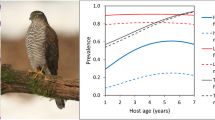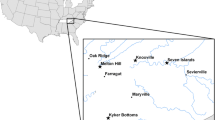Abstract
We describe the general field population biology of haemogregarines and mites in the wall lizard, Podarcis muralis, examining the factors that determine the prevalence and intensity of infection. The intensity of infection by haemogregarines in females was slightly lower in summer than in spring, whereas males maintained similar levels of intensity among all the seasons, probably due to immunosuppressive effects of testosterone. This is also supported because the prevalence and the infection intensity by mites were higher in males than in females. Parasite load was higher in lizards with better body condition, which could be reflecting the mortality of infected lizards with poor condition.

Similar content being viewed by others
References
Amo L, López P, Martín J (2004) Prevalence and intensity of Haemogregarinid blood parasites in a population of the Iberian Rock Lizard, Lacerta monticola. Parasitol Res 94:290–293
Barnard SM, Upton SJ (1994) A veterinary guide to the parasites of reptiles, vol. 1, Protozoa. Krieger, Malabar, Florida
Caudell JN, Whittier J, Conover MR (2002) The effects of haemogregarine-like parasites on brown tree snakes (Boiga irregularis) and slatey-grey snakes (Stegonotus cucullatus) in Queensland, Australia. Int Biodet Biodegrad 49:113–119
Eisen RJ (2001) Absence of measurable malaria-induced mortality in western fence lizards (Sceloporus occidentalis) in nature: a 4-year study of annual and over-winter mortality. Oecologia 127:586–589
Hamilton WD, Zuk M (1982) Heritable true fitness and bright birds: a role for parasites? Science 218:384–387
Holmes J (1995) Population regulation: a complex of interactions. Wildl Res 22:11–19
Hudson PJ, Dobson AP, Newborn D (1998) Prevention of population cycles by parasite removal. Science 282:2256–2258
Lainson R, de Souza MC, Franco CM (2003) Haematozoan parasites of the lizard Ameiva ameiva (Teiidae) from Amazonian Brazil: a preliminary note. Mem Inst Oswaldo Cruz 98:1067–1070
Levine ND (1982) Some corrections in haemogregarine (Apicomplexa: Protozoa) nomenclature. J Protozool 29:601–603
Merino S, Potti J (1995) High prevalence of hematozoa in nestings of a passerine species, the pied flycatcher (Ficedula hypoleuca). Auk 112:1041–1043
Møller AP, Christe P, Lux E (1999) Parasitism, host immune function, and sexual selection. Q Rev Biol 74:3–20
O’Dwyer LH, Moço TC, da Silva RJ (2004) Description of the gamonts of a small species of Hepatozoon sp. (Apicomplexa, Hepatozoidae) found in Crotalus durissus terrificus (Serpentes, Viperidae). Parasitol Res 92:110–112
Olsson M, Wapstra E, Madsen T, Silverin B (2000) Testosterone, mites and travels: a test of the immunocompetence-handicap hypothesis in free-ranging male sand lizards. Proc R Soc Lond B 267:2339–2343
Oppliger A, Celerier ML, Clobert J (1996) Physiological and behaviour changes in common lizards parasited by haemogregarines. Parasitology 113:433–438
Pacejka AJ, Gratton CM, Thompson CF (1998) Do potentially virulent mites affect house wren (Troglodytes aedon) reproductive success? Ecology 795:1797–1806
Pérez-Mellado V (1998) Podarcis muralis Laurenti, 1768. In Salvador A (ed) Reptiles. Fauna Ibérica, Vol. 10. Museo Nacional de Ciencias Naturales, Madrid, pp 283–294
Price PW (1980) Evolutionary biology of parasites. Princenton University Press, Princenton
van Riper CIII, van Riper SG, Goff ML, Laird M (1986) The epizootiology and ecological significance of malaria in Hawaiian land birds. Ecol Monog 56:327–344
Salvador A, Veiga JP, Martín J, López P, Abelenda M, Puerta M (1996) The cost of producing a sexual signal: testosterone increases the susceptibility of male lizards to ectoparasitic infestation. Behav Ecol 7:145–150
Schall JJ (1996) Malarial parasites of lizards. Adv Parasitol 37:255–333
Schuster JP and Schaub GA (2001) Experimental Chagas disease: the influence of sex and psychoneuroimmunological factors. Parasitol Res 87:994–1000
Sheldon BC, Verhulst S (1996) Ecological inmunology: costly parasite defences and trade-offs in evolutionary ecology. Trends Ecol Evol 11:317–321
Smallridge CJ, Bull CM (2000) Prevalence and intensity of the blood parasite Hemolivia mariae in a field population of the skink Tiquila rugosa. Parasitol Res 86:655–660
Smith TG, Desser SS, Martin DS (1994) The development of Hepatozoon sipedon n. sp. (Apicomplexa: Adeleina: Hepatozoidae) in its natural host, the Northern water snake (Nerodia sipedon sipedon), the culicine vectors, Culex pipiens and Culex territans, and an intermediate host, Northern leopard frog (Rana pipiens). Parasitol Res 80:559–568
Svahn K (1974) Incidence of blood parasites of the genus Karyolysus (Coccidia) in Scandinavian lizards. Oikos 25:43–53
Tokarz RR, McMann S, Seitz L, John-Alder H (1998) Plasma corticosterone and testosterone levels during the annual reproductive cycle of male brown anoles (Anolis sagrei). Physiol Zool 71:139–146
Veiga JP, Salvador A, Merino S, Puerta M (1998) Reproductive effort affects immune response and parasite infection in a lizard: a phenotypic manipulation using testosterone. Oikos 82:313–318
Wintrobe MM (1991) Clinical haematology. Lea and Feiberger, Philadelphia, PA
Acknowledgements
We thank “El Ventorrillo” MNCN Field Station for use of their facilities. We especially thank Santiago Merino for the photographs. Financial support was provided to L. Amo by an “El Ventorrillo” C.S.I.C. grant, to P. López by the MCYT project BOS 2002–00598, and to J. Martín by the MCYT project BOS 2002–00547. This study was performed under license of “Consejería de Medio Ambiente de la Comunidad de Madrid”. The experiments comply with the current laws of Spain where the experiments were performed.
Author information
Authors and Affiliations
Corresponding author
Rights and permissions
About this article
Cite this article
Amo, L., López, P. & Martín, J. Prevalence and intensity of haemogregarine blood parasites and their mite vectors in the common wall lizard, Podarcis muralis. Parasitol Res 96, 378–381 (2005). https://doi.org/10.1007/s00436-005-1354-2
Received:
Accepted:
Published:
Issue Date:
DOI: https://doi.org/10.1007/s00436-005-1354-2




